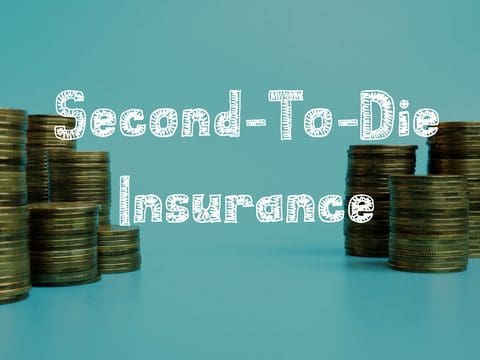Historically, affluent families primarily utilized second-to-die life insurance policies for estate tax protection.
However, with changes in the estate tax laws and the substantial increase in estate tax exemptions, many wealthy households no longer face estate taxes.
Despite this shift, second-to-die policies remain a valuable tool for strategic wealth transfer within families.
Our comprehensive guide explores how to leverage second-to-die life insurance to create generational wealth by highlighting its advantages in a clear, concise manner.
Quick navigation links
 Second to Die Policy as an Investment
Second to Die Policy as an Investment
A second-to-die life insurance policy is set up to insure married couples and does not pay out until the surviving spouse passes away.
Joint life insurance policies are an excellent long-term investment when you aim to pass the maximum amount to your children.Survivorship life offers a predictable mechanism to pass tax-free money to your beneficiaries through a wealth transfer strategy.
They offer a much better return on investment (ROI) than individual universal or whole-life policies.
These policies allow moderately wealthy families to leverage current assets to maximize their total net worth.
Here are just a few reasons why a second-to-die policy is a good investment for your family.

Inexpensive Coverage
One of the benefits of second-to-die policies is that they are more affordable than buying two separate policies.
This is because the insurance company only pays out the death benefit after both insureds pass away, which reduces the risk for the insurer.
We have found that the rate of returns is excellent for people who can qualify for either a preferred or standard health rating and pass away before age 95.
 Conservative Asset Class
Conservative Asset Class
Life insurance is a secure asset that offers beneficiaries a guaranteed and tax-free payout upon the policyholder’s death.
This means that regardless of market fluctuations or investment performance, the beneficiaries will receive an amount free from income tax obligations.
The fixed and guaranteed nature of life insurance ensures that it remains unaffected by changing economic conditions or the success of other investments.
It provides peace of mind knowing that loved ones will receive financial support when they need it most, without any additional tax burdens.
Great return on investment
Determining the value of second-to-die insurance as an investment requires comparing its rate of return to other assets such as stocks, bonds, and real estate.
When assessing coverage for our clients, we provide illustrations that display the internal rates of return on the death benefit at different ages.
These rates indicate how much you would need to earn from your other investments in order for a second-to-die policy to be a worthwhile addition to your estate-building strategy.
Typically, life insurance offers tax-free returns ranging from 6% to 8%, assuming an average life expectancy between 84 and 87 years old.
To match this level of return with taxable investments, you would need yields exceeding 9% to 11%.
We can also calculate the taxable equivalent rates based on your specific tax bracket, making comparing life insurance policies with alternative strategies for transferring family wealth easier.
 Tax-Free Death benefit
Tax-Free Death benefit
Is a second-to-die policy taxable upon my death? The great thing is that there is no income tax on a life insurance payout to your named beneficiaries, and a claim does not need to be reported to the IRS.
So, a significant advantage of second-to-die life insurance is that the life insurance company invests the premiums in taxable investments, and the death benefits are disbursed to your kid’s income tax-free.
In some cases, the beneficiary of a life insurance policy may elect to receive the death benefit in a series of installments.
If the beneficiary decides to keep the proceeds invested with the insurance company and receives a series of installments over time, any interest received on the installments will be taxed and must be reported on your taxes.
 Life Insurance for Estate Planning
Life Insurance for Estate Planning
Many affluent families incorporate second-to-die life insurance into their estate planning strategy when their gross estate is substantial enough to trigger an estate tax liability.
After the death of both spouses, the death benefit provides a timely cash injection, which helps settle estate taxes, preserves family assets, and alleviates financial stress during a challenging period.
As of 2024, each spouse can claim an exemption of $13.61 million individually, allowing couples to pass on up to $27.22 million without paying taxes. However, these federal estate tax exemptions may be significantly reduced by 2026.
Typically, the beneficiaries of a second-to-die policy are children or entities like Irrevocable Life Insurance Trusts (ILIT) or Dynasty Trusts.
If you foresee potential tax complications with your estate in the future, consider having an ILIT own your survivorship life policy to remove it from your taxable estate.
 Funding a Second to-die Policy
Funding a Second to-die Policy
Many couples with significant liquid assets wonder if they should fund coverage with a single premium or continue paying premiums throughout their lifetimes.
The advantage of premium payments spread out over time is that they can prevent the loss of a large upfront payment in the event of premature death.
However, a game changer for funding coverage with a lump sum is called annuity arbitrage. This strategy involves buying a survivorship policy and an annuity from different insurance companies but on the same person(s).
The income generated from the annuity can then be used to cover the life insurance policy premiums. The goal is to generate a higher interest rate than what would be earned on the policy’s cash value by using an annuity.
By implementing this approach, one can secure a tax-free income stream for their lifetime or a specific period through the annuity component while potentially obtaining more significant death benefits.
If you both die prematurely, your beneficiaries will get the remaining annuity balance and the life insurance death benefits.
To execute this strategy, you need an experienced agent who can obtain competitive life insurance offers and attractive annuity payout ratey.
⊕
Annuity Arbitrage with Life Insurance Case Study:
Frank and Mary wanted to leave a $1,000,000 legacy for their children. They bought a second-to-die life insurance policy that costs $15,721 per year.
They could have paid $287,000 upfront for the policy, but they found a smarter way.
They put $250,000 into an annuity that pays them $15,721 for as long as they live. They use this money to pay for the life insurance policy.
The annuity guarantees that they will never run out of money to pay for the policy, even if they live very long.
If they die before the annuity pays out the full $250,000, their children will get the remaining balance (plus the life insurance).
This way, they save money if they live longer than expected because they only spend $250,000 without any extra payments.
 Second-to-Die Life Insurance Rates
Second-to-Die Life Insurance Rates
People are often surprised to learn that second-to-die policies are lower in cost, easier to buy, and have better investment returns than purchasing individual life insurance.
If you want to get started with some initial life insurance quotes, use our calculator to compare rates from top-rated insurance companies.
Remember, these initial estimates may require adjustments to fit your unique needs perfectly. You can contact us at 877-249-1358 or fill out our form to start securing your quote today!
 Second-to-die Life Insurance Quotes
Second-to-die Life Insurance Quotes
Tips for Buying a 2nd to Die Policy
To guarantee the most suitable policy for your family’s requirements, it is crucial to conduct thorough research and comprehend the process involved.
By being knowledgeable about this topic, you can make an educated choice that aligns with your goals of transferring wealth or planning your estate effectively.
 Qualifying for coverage
Qualifying for coverage
These policies have more lenient underwriting even when one person has health issues or is older; they may still be eligible if the other insured is in decent health.
Various factors come into play during the qualification process and when determining premium rates, including the spouse’s age, health status, and lifestyle.
Additionally, applicants might be required to undergo a medical examination or provide relevant medical records, blood tests, or urine samples.
The insurance company will carefully review all this information to assess risk profiles and coverage needs before calculating appropriate premiums.
 Choosing A death benefit
Choosing A death benefit
When deciding on the death benefit amount for your life insurance policy, it’s crucial to consider your specific needs and goals.
This includes factors such as estate planning objectives, financial circumstances, and the requirements of your beneficiaries.
You should also consider the estimated value of your estate and potential estate taxes applicable after you and your spouse pass away.
Additionally, consider how much money you want to leave behind for your heirs, whether it be children, grandchildren, or charitable organizations.
Lastly, don’t forget to factor in the costs of maintaining the policy throughout the remainder of your lifetime.
 Buy a Guaranteed Second to Die Policy
Buy a Guaranteed Second to Die Policy
There are many types of second-to-die life insurance policies, such as survivorship universal life, survivorship variable life, and survivorship whole life insurance.
Considering policies with contractually fixed premiums is a smart move for those searching for the best rates and guaranteed lifelong coverage.
Survivorship universal life (SUL) is the most cost-effective because it prioritizes death benefits over cash value growth.
Be wary of plans without fixed premiums because varying interest rates might cause them to lapse!
If you’re navigating issues with an underperforming policy, please do yourself a favor and read this article on dealing with second-to-die insurance problems.
With this in mind, we have provided you with sample guaranteed second-to-die life insurance rates.
| Ages | Premium | Death Benefit |
| 60/60 | $10,100 | $1,000,000 |
| 65/65 | $13,200 | $1,000,000 |
| 70/70 | $18,200 | $1,000,000 |
| 75/75 | $24,100 | $1,000,000 |
Discover personalized life insurance quotes for your family with our comparison tool. We promise to match you with the top insurers and get you the best rates.
Remember that these preliminary estimates might need fine-tuning to align perfectly with your requirements.
For a tailored plan, complete our contact form to begin crafting your second-to-die life insurance quote today!
Second To Die Life Insurance Rates
 Select a Solid Life Insurance Company
Select a Solid Life Insurance Company
The rates you receive for second-to-die life insurance will depend on the specific insurance company you choose. Each insurer has its own pricing structure and standards for evaluating applicants, which can impact your premiums.
Selecting an insurance company with solid financials is important, as this ensures their ability to pay claims.
Rating agencies assess insurers’ financial strength and claims-paying ability, providing a grade that helps policyholders make informed decisions.
To simplify your search for affordable second-to-die policies, we work with several reputable insurance companies that have excellent ratings from trusted sources like the Better Business Bureau, AM Best, and J.D. Power.
Second to Die Insurance Companies
| COMPANY | BBB | AM Best | JD Power |
| American General | A+ | A | 718 |
| John Hancock | A+ | A+ | 739 |
| Lincoln Financial | A+ | A+ | 744 |
| Mass Mutual | A+ | A++ | 780 |
| Mutual of Omaha | A+ | A+ | 766 |
| Nationwide | A+ | A+ | 806 |
| Pacific Life | A+ | A+ | N/A |
| Principal Financial | A+ | A+ | 774 |
| Protective Life | A+ | A+ | 742 |
| Prudential | A | A+ | 770 |
Select a Reputable Financial Planner
Are you in the market for a second-to-die life insurance policy? You’re not alone. Many people are looking for this coverage as they approach retirement age.
Before buying, ensure you know what to look for and how to get the best deal.
Many agents have never sold a second-to-die policy. So, they have not developed the product knowledge or the carrier relationships needed to secure the best premium class for their clients.
At Affordable Life USA, we have qualified life insurance agents and financial planners who will help you get more accurate second-to-die life insurance quotes that fit your needs and budget.
Trending Estate Planning Topics
-
Affordable Life USA offers comprehensive life insurance solutions to families and business owners throughout the United States.
Our founder, Eric Van Haaften, developed his passion for quantitative analysis while earning his business degree from Ferris State University, which laid a strong foundation for his analytical approach to financial planning.
Eric has obtained a professional LUTCF designation, awarded by the National Association of Insurance and Financial Advisors and the American College of Financial Services.
Another professional accolade is qualifying for the prestigious Million Dollar Round Table. Eric also serves as the treasurer of the Senior Sing Along charity.
Eric Van Haaften, LUTCF

-
Affordable Life USA
Email: eric@affordablelifeusa.com 2524 Wodmeadow Grand Rapids, MI 49546
1-877-249-1358
Affordable Life USA, LLC ™ © 2025 All rights reserved
 Conservative Asset Class
Conservative Asset Class Tax-Free Death benefit
Tax-Free Death benefit Life Insurance for Estate Planning
Life Insurance for Estate Planning Funding a Second to-die Policy
Funding a Second to-die Policy Second-to-Die Life Insurance Rates
Second-to-Die Life Insurance Rates

 Qualifying for coverage
Qualifying for coverage Choosing A death benefit
Choosing A death benefit Buy a Guaranteed Second to Die Policy
Buy a Guaranteed Second to Die Policy Select a Solid Life Insurance Company
Select a Solid Life Insurance Company



